 |
|
Los Angeles International Airport |
| Los Angeles International Airport |
 |
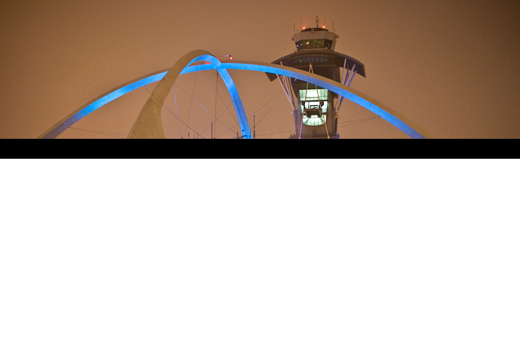 |
| IATA: LAX – ICAO: KLAX – FAA LID: LAX
Location of the Los Angeles International Airport
|
| Summary |
| Airport type |
Public |
| Owner |
City of Los Angeles |
| Operator |
Los Angeles World Airports |
| Serves |
Greater Los Angeles metropolitan area |
| Location |
Los Angeles, California, United States |
| Hub for |
- Alaska Airlines
- American Airlines
- Horizon Air
- United Airlines
|
| Elevation AMSL |
126 ft / 38 m |
| Coordinates |
33°56′33″N 118°24′29″W / 33.9425°N 118.40806°W / 33.9425; -118.40806 |
| Website |
www.lawa.org |
| Runways |
| Direction |
Length |
Surface |
| ft |
m |
| 6L/24R |
8,925 |
2,720 |
Concrete |
| 6R/24L |
10,285 |
3,135 |
Concrete |
| 7L/25R |
12,091 |
3,685 |
Concrete |
| 7R/25L |
11,096 |
3,382 |
Concrete |
| Helipads |
| Number |
Length |
Surface |
| ft |
m |
| H3 |
63 |
19 |
Concrete |
Source: Federal Aviation Administration
|
Los Angeles International Airport (IATA: LAX, ICAO: KLAX, FAA LID: LAX) is the primary airport serving Los Angeles, California, the second-most populated metropolitan area of the United States. It is most often referred to by its IATA airport code LAX, with the letters pronounced individually (el-a-ex). LAX is located in southwestern Los Angeles in the neighborhood of Westchester, 16 mi (26 km) from the downtown core.
With 59,542,151 passengers in 2009, LAX is the sixth busiest airport in the world. The airport is a major hub for United Airlines, Alaska Airlines and American Airlines and a focus city for Southwest Airlines, Allegiant Air, Air New Zealand and Virgin America. It also serves as an international gateway for Delta Air Lines.
The airport also functions as joint civil-military facility, providing a base for the United States Coast Guard and its Coast Guard Air Station Los Angeles facility, operating 4 HH-65 Dolphin helicopters.
LAX is the busiest airport in California in terms of flight operations, passenger traffic and air cargo activity, followed by San Francisco International Airport (SFO). LAX is also the only U.S. airport to serve 3 or more international destinations with ridership of 1 million passengers or more per year (Tokyo-Narita, London-Heathrow, Taipei).
Although LAX is the busiest airport in the Greater Los Angeles Area, the region relies on a multiple airport system because of its vast size. Many of the area's most well-known attractions are closer to alternative airports than to LAX; for example, Hollywood and Griffith Park are closer to Bob Hope Airport in Burbank, while Disneyland, the Honda Center, Angel Stadium of Anaheim, and other Orange County attractions are closer to John Wayne Airport in Orange County. Long Beach Airport is closer to some of the coastal attractions known to Southern California like Palos Verdes and Huntington Beach, and LA/Ontario International Airport is closer to the major cities of the Inland Empire, Riverside and San Bernardino.
The airport occupies some 3,500 acres (5 sq mi; 14 km) of the city on the Pacific coast, about 15 mi (24 km) southwest of downtown Los Angeles. LAX is one of the most famous locations for commercial aircraft spotting, most notably at the so called "Imperial Hill" area (also known as Clutter's Park) in El Segundo from which nearly the entire South Complex of the airport can be viewed. Another famous spotting location sits right under the final approach for runways 24 L&R on a small grass lawn next to the Westchester In-N-Out Burger restaurant, and is noted as one of the few remaining locations in Southern California from which spotters may watch such a wide variety of low-flying commercial airliners from directly underneath a flightpath. The airport's coastal location renders it liable to low lying cloud or fog conditions requiring flights to be occasionally diverted to LA/Ontario International Airport, 47 mi (76 km) to the east. History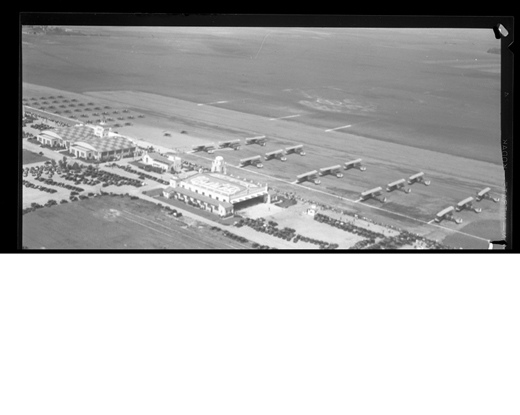 | |
Los Angeles Municipal Airport on Army Day, circa 1931. |
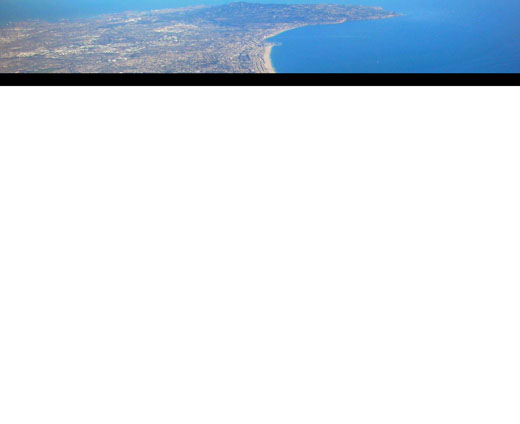 | |
Los Angeles International Airport with Marina Del Rey in the foreground and Palos Verdes Peninsula in the background. |
In 1928, the Los Angeles City Council selected 640 acres (1.00 sq mi; 2.6 km) in the southern part of Westchester as the site of a new airport for the city. The fields of wheat, barley and lima beans were converted into dirt landing strips without any terminal buildings. It was named Mines Field for William W. Mines, the real estate agent who arranged the deal. The first structure, Hangar No. 1, was erected in 1929 and is listed on the National Register of Historic Places.
Mines Field was dedicated and opened as the official airport of Los Angeles in 1930, and the city purchased it to be a municipal airfield in 1937. The name was officially changed to Los Angeles Airport in 1941, and to Los Angeles International Airport (LAX) in 1949. Prior to that time, the main airline airports for Los Angeles were Burbank (then known as Union Air Terminal, and later Lockheed) and the Grand Central Airport in Glendale. By 1940 most airlines served Burbank only; starting in 1946 they served LAX (and perhaps Burbank as well).
Until this time, the entire airport was located east of Sepulveda Boulevard. As the airport expanded westward to meet the Pacific Ocean, Sepulveda Blvd was rerouted to the west to loop around the west ends of the extended east-west runways (now runways 25L and 25R), which by November 1950 were 6,000 ft (1,800 m) long. (Aerial view looking south) A tunnel was completed in 1953 so that Sepulveda Boulevard could revert to straight and pass beneath the two runways; it was the first tunnel of its kind. For the next few years the two runways were 8,500 ft (2,600 m) long.
In 1958 the architecture firm Pereira & Luckman was contracted to design a master plan for the complete re-design of the airport in anticipation of the "jet age". The plan, developed along with architects Welton Becket and Paul Williams, called for a massive series of terminals and parking structures to be built in the central portion of the property, with these buildings connected at the center by a huge steel-and-glass dome. The plan was never fully realized, and shortly thereafter the Theme Building was constructed on the site originally intended for the dome.
The distinctive white "Theme Building", designed by Pereira & Luckman architect Paul Williams and constructed in 1961, resembles a flying saucer that has landed on its four legs. A restaurant that provides a sweeping view of the airport is suspended beneath two intersecting arches that form the legs. The Los Angeles City Council designated the building a cultural and historical monument in 1992. A $4 million renovation, with retro-futuristic interior and electric lighting designed by Walt Disney Imagineering, was completed before the "Encounter Restaurant" opened there in 1997. Tourists and passengers are able to take the elevator up to the roof of the "Theme Building", which closed after the September 11 attacks for security reasons and reopened to the public on weekends beginning on June 10, 2010.
The first jet service appeared at LAX in 1959, transporting passengers between LAX and New York. The first wide-bodied jets appeared in 1970 when TWA flew Boeing 747s between LAX and New York. All terminals were originally satellite buildings separated from the ticketing area and accessed by underground tunnels.
In 1981, the airport began a substantial $700 million expansion in preparation for the 1984 Summer Olympics. To streamline traffic flow and ease congestion, the U-shaped roadway leading to the terminal entrances was given a second level, with the lower level dedicated to picking up arriving passengers and the upper level dedicated to dropping off departing passengers. Connector buildings between the ticketing areas and the satellite buildings were added, changing the gate layout to a "pier" design and completely enclosing the facilities. Two new terminals (Terminal 1 and the International Terminal) were constructed and Terminal 2, then two decades old, was rebuilt. Multi-story parking structures were also built in the center of the airport.
On July 8, 1982, groundbreaking for the two new terminals were conducted by Mayor Tom Bradley and World War II aviator General James Doolittle. The $123 million, 963,000-square-foot (89,500 m) International Terminal was opened on June 11, 1984 and named in Bradley's honor.
On April 29, 1992, the airport was closed for violence and clean ups, due to 1992 Los Angeles Riots over the Rodney King beating.
The airport was closed again on January 17, 1994, due to the Northridge Earthquake which happened at 4:31 am.
In 1996, a new 277 foot (84 m) tall air traffic control tower, with overhanging awnings that shade the windows and make the building vaguely resemble a palm tree, was constructed near the Theme Building at a cost of $29 million.
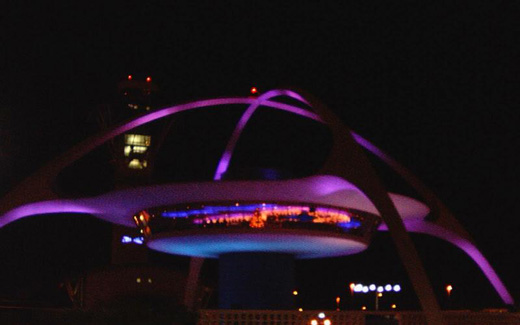 | |
The Theme Building decorated with light displays for the holidays |
In 2000, prior to Los Angeles hosting the Democratic National Convention, fourteen acrylic glass cylinders, each up to ten stories high, were placed in a circle around the intersection of Sepulveda Boulevard and Century Boulevard, with additional cylinders of decreasing height following Century Boulevard eastward. The cylinders, lit from inside, slowly cycle through a rainbow of colors, and provide an additional landmark for visitors arriving by air at night. This was part of an overall facelift that included new signage and various other cosmetic enhancements. LAX pylons underwent improvements in 2006, as stage lighting inside the cylinders was replaced with LED lights to conserve energy, make maintenance easier and to enable on-demand cycling through various color effects.
At various points in its history, LAX has been a hub for TWA, Air California, Continental, Delta, PSA, USAir, Western Airlines, and the Flying Tiger Line.
Starting in the mid-1990s under Los Angeles Mayors Richard Riordan and James Hahn modernization and expansion plans for LAX were prepared, only to be stymied by a coalition spearheaded by residents who live near the airport angry at noise, pollution and traffic impacts of the existing facility. In late 2005 newly elected L.A. Mayor Antonio Villaraigosa was able to reach a compromise, allowing some modernization to go forward while efforts are made to encourage future growth be spread among other facilities in the region.
It is illegal to limit the number of passengers that can use an airport; however, in December 2005 the city agreed to limit their construction of passengers gates to 163. Once passenger usage hits 75 million, a maximum of 2 gates a year for up to five years will be closed, which theoretically will limit maximum growth to 79 million passengers a year. In exchange civil lawsuits were abandoned, to allow the city to complete badly needed improvements to the airport.
On July 29, 2006, Runway 7R/25L was closed for reconstruction until March 25, 2007. The reconstruction was to move the runway 55 feet (17 m) south to prevent runway incursions and prepare the runway for the next generation of Airbus A380 jets. The newly moved runway also has storm drains, and enhanced runway lighting, something that the other three runways do not have. Runway 25L is now 800 ft south of the parallel runway, centerline to centerline, which is enough room for a parallel taxiway between the runways; the taxiway was completed in 2008.
On September 18, 2006, Los Angeles World Airports started a $503 million facelift of the Tom Bradley International Terminal. Improvements include installing new paging, air conditioning and electrical systems, along with new elevators, escalators, baggage carousels, and a digital sign that will automatically update flight information. Also a large explosives-detection machine will be incorporated into the terminal's underground baggage system, and the federal government will fund part of the system.
According to the Los Angeles Times, in February 2007, many airlines flying outside of the United States have reduced flights to LAX and moved to other airports, such as San Francisco International Airport and McCarran International Airport in Las Vegas, Nevada, due to outdated terminals. Airlines flying out of the Tom Bradley International Terminal have reduced flights because the International Terminal is 22 years old and has not been upgraded.
In response to the report, the $500 million Tom Bradley International Terminal project began immediately.
On March 19, 2007, the Airbus A380 made its debut at LAX, landing on runway 24L. LA city officials fought for the super-jumbo jet to land at LAX, in addition to making its US debut in New York's JFK airport.
On August 15, 2007, the Los Angeles City Council approved a $1.2 billion project to construct a new 10-gate terminal to handle international flights using the A380. Adding the first new gates built since the early 1980s, the new structure is to be built directly west of the Tom Bradley International Terminal on a site that is occupied mostly by aircraft hangars, with passengers to be ferried to the building by an underground people mover extending from the terminal. It is expected to be completed in 2012.
On March 31, 2008, the Los Angeles Times reported that international airlines were once again flocking to LAX's Tom Bradley International Terminal and have added or are announcing several flights to a variety of existing and new destinations. The weak dollar has caused a surge in demand for US travel, and among the new airlines at LAX are V Australia and Emirates Airlines. In addition, Korean Air, Qantas, Air China, and Air France are all adding new routes, and Brazilian carriers TAM Airlines and OceanAir are planning to begin service, as is a new British airline that will be offering all-business-class round trip flights on the busy Los Angeles-London route. Most of the new flights will start in mid to late 2008 and will raise the number of travelers to the airport to pre-9/11 levels. The influx of new flights comes amidst the renovation of the airport and underscores LAX's status as the international gateway of the US West Coast.
Qantas launched service with the Airbus A380 on October 20, 2008, using the west side remote gates. The select day service goes to/from Melbourne and Sydney to Los Angeles.
The "X" in LAX
Before the 1930s, existing airports used a two-letter abbreviation based on the weather station at the airports. So, at that time, LA served as the designation for Los Angeles International Airport. But, with the rapid growth in the aviation industry, the designations expanded to three letters, and LA became LAX. The letter X does not otherwise have any specific meaning in this identifier. Portland International Airport in Oregon also uses a similar code, PDX. "LAX" is also used for the Port of Los Angeles in San Pedro and by Amtrak for Union Station in downtown Los Angeles.
Terminals
LAX handled 28,861,477 enplanements, the total number of passengers boarding an aircraft, in 2008. This makes LAX the third busiest airport in the U.S. in terms of enplanements. It is the world's sixth-busiest airport by passenger traffic and eleventh-busiest by cargo traffic, serving over 60 million passengers and more than two million tons of freight in 2006. It is the busiest airport in the state of California, and the third-busiest airport by passenger traffic in the United States based on final 2006 statistics. In terms of international passengers, LAX is the second-busiest in the U.S. (behind only JFK International Airport in New York City), and 26th worldwide.
LAX connects 87 domestic and 69 international destinations in North America, Latin America, Europe, the Middle East, Asia and Oceania. Its most prominent airlines are United Airlines (18.24% of passenger traffic, combined with United Express traffic), American Airlines (14.73%) and Southwest Airlines (12.62%). Other airlines with a presence on a lesser scale include Delta Air Lines (11.12%), Alaska Airlines (4.74%), and Continental Airlines (3.76%).
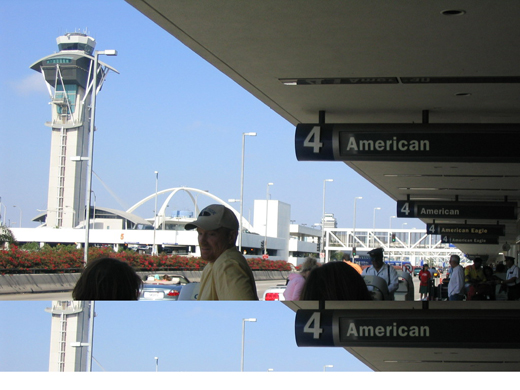 | |
The LAX control tower and Theme Building as seen from Terminal 4 |
LAX has nine passenger terminals arranged in a "U", also called a "horseshoe." The terminals are served by a shuttle bus.
United Airlines/United Express operates the most departures from the airport per day (210), followed by American Airlines/ American Eagle (126), and Southwest Airlines (123).
United Airlines operates to the most destinations followed by American Airlines and Alaska Airlines/Horizon. The largest international carriers at LAX include Qantas, Air New Zealand, Air Canada, Air France, Lufthansa, British Airways, and Korean Air.
In addition to these terminals, there are 2 million square feet (186,000 m²) of cargo facilities at LAX, and a heliport operated by Bravo Aviation. Continental Airlines and Qantas each have maintenance facilities at LAX although neither carrier operates a hub there.
Terminal 1
Terminal 1 has 15 gates: 1-3, 4A-4B, 5-14 and houses Southwest Airlines, US Airways, and US Airways Express. Terminal 1 was built in 1984 and was occupied by Pacific Southwest Airlines (PSA), AirCal, Muse Air, and USAir. It is the largest of all the terminals in terms of number of gates.
Terminal 2
Note: Some TACA/LACSA arrivals are processed at the Tom Bradley International Terminal.
Terminal 2 has 11 gates: 21-21B, 22-22B, 23, 24-24B, 25-28. It houses several international airlines such as Air Canada, Air France, Air New Zealand, KLM, and Volaris. Terminal 2 was built in 1962 and was the original international terminal, it was completely torn down and rebuilt in 1984. Terminal 2 has CBP (Customs and Border Protection) facilities to process arriving international passengers. For many years, it housed Northwest Airlines, until service moved to Terminal 5 in 2009 after merging with Delta Air Lines, since then, the terminal has primarily served international flights.
Terminal 3
Note: V Australia's and Alaska Airlines' international arrivals from airports without United States border preclearance are processed at the Tom Bradley International Terminal.
Terminal 3 has 12 gates: 30, 31A, 31B, 32, 33A, 33B, 34-36, 37A, 37B, 38, [gate 39 was removed to make room for V Australia 777 operations at gate 38]. Terminal 3 opened in 1961 and was Trans World Airlines' terminal. It formerly housed some American Airlines flights after acquiring Reno Air and TWA in 1999 and 2001, respectively, then moved all American flights to Terminal 4. As of late-2009, Alaska Airlines and Virgin America are the primary tenants of Terminal 3.
Terminal 4
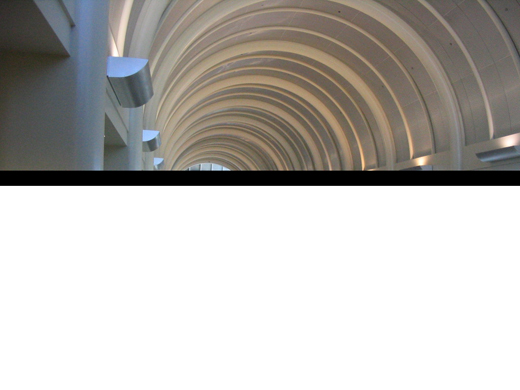 | |
Interior view of Terminal 4 |
Note: American Eagle flights operate from a remote terminal just east of Terminal 8. Gate 44 serves as the shuttle bus stop at Terminal 4. Gate 44 is also connected by shuttle buses to Terminals 2 (Gate 22A), 3 (Gate 35), and 5, because of Eagle's codesharing with Hawaiian, Alaska, and Delta respectively.
Terminal 4 has 14 gates: 40, 41, 42A, 42B, 43, 44 (bus to American Eagle satellite terminal), 45, 46A, 46B, 47A, 47B, 48A, 48B, 49B. Terminal 4 was built in 1961 and in 2001 was renovated at a cost of $400 million in order to improve the appearance and functionality of the terminal. It is home for American Airlines, which operates its West Coast hub at the Airport. American is the only tenant at T4 other than occasional Qantas departures. An international arrivals facility was also added in the renovation serving American Airlines flights.
Terminal 5
Terminal 5 has 14 gates: 50B, 51A-51B, 52A-52B, 53A-53B, 54A-54B, 55A, 56, 57, 58A, 59. Western Airlines had occupied this terminal since its opening in 1962, and then Western was merged with Delta Air Lines on April 1, 1987. Terminal 5 was re-designed, expanded to include a connector building between the original satellite and the ticketing facilities, and remodeled from 1986 through early 1988. It was unofficially named 'Delta's Oasis at LAX' with the slogan 'Take Five at LAX' when construction was completed in the summer of 1988. Northwest Airlines moved all operations to Terminal 5 and Terminal 6 alongside Delta Air Lines June 30, 2009 as part of their merger with the airline.
Terminal 6
 | |
A Virgin America Airbus A319 at Terminal 6. In December 2008, Virgin America moved to Terminal 3. |
Terminal 6 has 14 gates: 60, 61, 62-62A, 63-66, 67A-67B, 68A-68B, 69A-69B. This terminal has changed little from its opening in 1961; in 1979, new gates were expanded from the main building, as is obvious from the rotunda at the end. Four of these gates have two jetways, which can accommodate large aircraft.
Terminal 6 hosts airline tenants with a variety of relationships with the Airport. Continental built and owns the Connector Building (which links the Ticketing and rotunda buildings), and leases much of the space in the Ticketing Building. Continental in turn leases some of its Connector gates to Delta, supplementing its base at Terminal 5. United leases space from the Airport in Terminal 6, in addition to its base at Terminal 7. Most of the rotunda gates can feed arriving passengers into a sterile corridor that shunts them to Terminal 7's customs and immigration facility. Other airlines, such as AirTran, Frontier, JetBlue, and Spirit, lease space and operate at Terminal 6 under a monthly tariff agreement. Also, one foreign-flag airline, Copa, departs from Terminal 6.
Terminal 7
Terminal 7 has 11 gates: 70A-70B, 71A-71B, 72-74, 75A-75B, 76, 77. This terminal opened in 1962. Five of these gates have two jetways, which accommodate large aircraft. Terminal 7 is the home to United Airlines, which operates a major hub at the airport. The terminal has been renovated and has the United Red Carpet Club and International First Class Lounge.
Terminal 8
Terminal 8 has 9 gates: 80-88. This terminal was added for smaller jets and turboprops in 1988 and formerly served Shuttle by United flights. In 2002, United moved all non-Express flights to Terminals 6 and 7. However, Terminal 8 is now used once again for mainline United flights.
Tom Bradley International Terminal (TBIT)
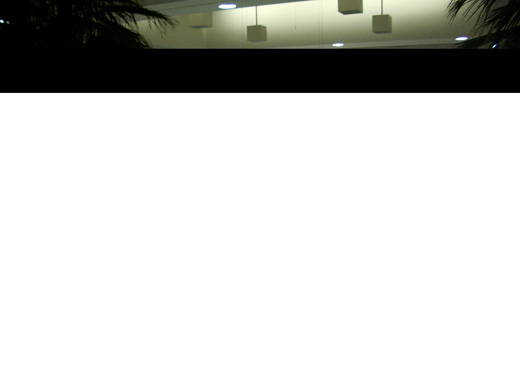 | |
Tom Bradley International Terminal in the early morning |
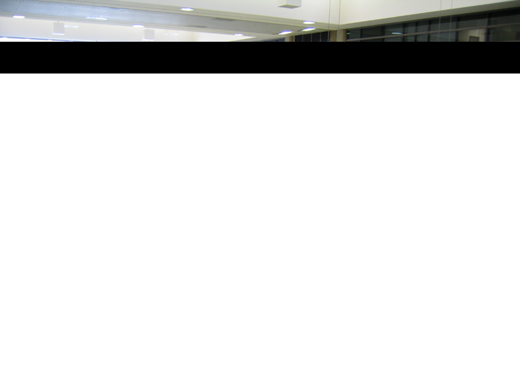 | |
Check-in counters in the Tom Bradley International Terminal |
The Tom Bradley International Terminal has 12 gates, including six on the north concourse and six on the south concourse. In addition, there are nine satellite gates for international flights located on the west side of LAX. Passengers are ferried to the west side gates by bus. The terminal hosts most of the major international airlines not in terminal 2 including British Airways, Lufthansa and Swiss Airlines and most major Asian Airlines.
This terminal opened for the 1984 Summer Olympic Games and is named in honor of Tom Bradley, the first African-American and longest serving (20 years) mayor of Los Angeles, and champion of LAX. The terminal is located at the west end of the passenger terminal area between Terminals 3 and 4. There are 34 airlines that serve the Tom Bradley International Terminal and the terminal handles 10 million passengers per year.
The terminal is currently undergoing major renovations to facelift and modernize the entire facility and add more building space for baggage screening equipment. The renovations include refreshed check in space with inline baggage screening, three large alliance aligned lounges plus one unaligned lounge (to replace the multiple airline specific lounges) and fully facelifted departures and arrivals areas. These renovations are expected to be completed by 2010. The current renovations do not add any new gates.
On November 17, 2008, Mayor Antonio Villaraigosa unveiled vision design concepts for LAX's Bradley West and Midfield Concourse projects. Los Angeles World Airports (LAWA), along with city officials, selected Fentress Architects in association with HNTB to develop a design concept for the modernization of LAX. The emphasis of the modernization is to improve the passenger experience.
On February 22, 2010, construction began on the $1.5 billion Bradley West program, designed by Curtis W. Fentress, FAIA, RIBA of Fentress Architects. The project will add over 1,250,000 square feet (116,000 m) of shops, restaurants, and passenger lounges, as well as new security screening, customs and immigration, and baggage claim facilities. The terminal's existing two concourses will be demolished and replaced with a larger pair with 16 gates, nine of which will be able to accommodate super jumbo aircraft. The timeline for the project includes phased openings beginning in early 2012, with the full Bradley West program concluding in early 2014.
Airlines and destinations
LAX handles more "origin and destination" (i.e. not connecting) passengers than any other airport in the world. It is the world's fifth-busiest airport by passenger traffic and eleventh-busiest by cargo traffic, serving over 60 million passengers and more than two million tons of freight in 2006. It is the busiest airport in the state of California, and the third-busiest airport by passenger traffic in the United States based on final 2006 statistics. In terms of international passengers, LAX is the second-busiest in the U.S. (behind only New York–JFK), and 26th worldwide.
United Airlines/United Express operates the most departures from the airport followed by American Airlines/American Eagle and Southwest Airlines. United also operates to the most destinations, followed by American and Alaska Airlines/Horizon. Qantas operates the most international trans-Pacific destinations (4), with nonstop service to Sydney, Melbourne, Brisbane, and Auckland. Lufthansa serves the most destinations in Europe, while Alaska Airlines serve the most destinations in Latin America.
| Airlines |
Destinations |
Terminal |
| Aeroflot |
Moscow-Sheremetyevo |
TBIT |
| Aeroméxico |
Guadalajara, Mexico City |
2 |
| Aeroméxico Connect |
Aguascalientes, Culiacán, Hermosillo, León/El Bajío |
2 |
| Air Berlin |
Düsseldorf [seasonal] |
TBIT |
| Air Canada |
Calgary, Montréal-Trudeau, Toronto-Pearson, Vancouver |
2 |
| Air China |
Beijing-Capital |
2 |
| Air France |
Papeete, Paris-Charles de Gaulle |
2 |
| Air New Zealand |
Apia, Auckland, London-Heathrow, Nuku'alofa (Tonga), Rarotonga |
2 |
| Air Pacific |
Nadi |
TBIT |
| Air Tahiti Nui |
Papeete, Paris-Charles de Gaulle |
TBIT |
| AirTran Airways |
Atlanta, Milwaukee
Seasonal: Baltimore |
6 |
| Alaska Airlines |
Guadalajara, Ixtapa/Zihuatanejo, Manzanillo, Mazatlán, Mexico City, Portland (OR), Puerto Vallarta, San José del Cabo, Seattle/Tacoma, Vancouver, Washington-Reagan
Seasonal: Anchorage |
3 |
| Alitalia |
Rome-Fiumicino |
2 |
| Allegiant Air |
Bellingham, Billings, Des Moines, Eugene, Fargo, Fayetteville (AR), Grand Junction, Idaho Falls [ends October 8], Medford, Missoula, Pasco, Sioux Falls, Springfield (MO), Wichita |
6 |
| All Nippon Airways |
Tokyo-Haneda [begins October 31], Tokyo-Narita |
TBIT |
| American Airlines |
Austin, Boston, Chicago-O'Hare, Dallas/Fort Worth, Honolulu, Kahului, Kona, Las Vegas, Lihue, London-Heathrow, Miami, Nashville, New York–JFK, Newark, Orlando, St. Louis, San Francisco, San José del Cabo, San Juan, San Salvador, Tokyo-Narita, Toronto-Pearson, Washington-Dulles
Seasonal: Eagle/Vail |
4 |
| American Eagle |
Denver, Fresno, Monterey, Reno/Tahoe, San Diego, San Jose (CA), Santa Barbara, Santa Fe |
4 |
| Asiana Airlines |
Seoul-Incheon |
TBIT |
| Avianca |
Bogotá |
2 |
| British Airways |
London-Heathrow |
TBIT |
| Cathay Pacific |
Hong Kong |
TBIT |
| China Airlines |
Taipei-Taoyuan |
TBIT |
| China Eastern Airlines |
Shanghai-Pudong |
TBIT |
| China Southern Airlines |
Guangzhou |
TBIT |
| Continental Airlines |
Cleveland, Honolulu, Houston-Intercontinental, Kahului, Newark |
6 |
| Copa Airlines |
Panama City |
6 |
| Delta Air Lines |
Atlanta, Cincinnati/Northern Kentucky, Columbus (OH), Detroit, Fort Lauderdale, Guatemala City, Honolulu, Indianapolis, Kahului, Kona, Las Vegas [begins December 18], Lihue, Memphis, Minneapolis/St. Paul, New Orleans, New York–JFK, Orlando, Salt Lake City, San Francisco, Sydney, Tampa, Tokyo-Haneda [begins January 29], Tokyo-Narita
Seasonal: Cancún, Guadalajara, Puerto Vallarta, Raleigh/Durham |
5,6 |
| Delta Connection operated by SkyWest Airlines |
Las Vegas, Phoenix [resumes March 3], Salt Lake City, San Diego, San Francisco |
5 |
| Frontier Airlines |
Denver, Milwaukee |
6 |
| Frontier Airlines operated by Republic Airlines |
Denver, Kansas City, Omaha [begins February 14] |
6 |
| El Al |
Tel Aviv |
TBIT |
| Emirates |
Dubai |
TBIT |
| EVA Air |
Taipei-Taoyuan |
TBIT |
| Hawaiian Airlines |
Honolulu |
2 |
| Horizon Air |
Eureka/Arcata, La Paz, Loreto, Mammoth Lakes, Medford, Portland (OR), Redding, Reno/Tahoe, San Jose (CA), Santa Rosa, Seattle/Tacoma
Seaonal: Sun Valley |
3 |
| Japan Airlines |
Tokyo-Narita |
TBIT |
| JetBlue Airways |
Boston, New York–JFK |
6 |
| KLM |
Amsterdam |
2 |
| Korean Air |
São Paulo-Guarulhos, Seoul-Incheon, Tokyo-Narita |
TBIT |
| LAN Airlines |
Lima, Santiago de Chile |
TBIT |
| LAN Perú |
Lima |
TBIT |
| Lufthansa |
Frankfurt, Munich |
TBIT |
| Malaysia Airlines |
Kuala Lumpur, Taipei-Taoyuan |
TBIT |
| Philippine Airlines |
Manila |
TBIT |
| Qantas |
Auckland, Brisbane |
4 |
| Qantas |
Melbourne, Sydney |
TBIT |
| Singapore Airlines |
Singapore, Tokyo-Narita |
TBIT |
| Southwest Airlines |
Albuquerque, Austin, Baltimore, Chicago-Midway, Denver, El Paso, Houston-Hobby, Kansas City, Las Vegas, Nashville, New Orleans [begins November 7], Oakland, Phoenix, Reno/Tahoe, Sacramento, St. Louis, Salt Lake City, San Antonio, San Francisco, San Jose (CA), Tucson |
1 |
| Spirit Airlines |
Detroit, Fort Lauderdale |
6 |
| Sun Country Airlines |
Minneapolis/St. Paul [seasonal] |
2 |
| Swiss International Air Lines |
Zürich |
TBIT |
| TACA |
Guatemala City, |
2 |
| TACA operated by Lacsa |
Guatemala City, San José de Costa Rica |
2 |
| Thai Airways International |
Bangkok-Suvarnabhumi |
TBIT |
| Turkish Airlines |
Istanbul-Atatürk [begins March 3] |
TBIT |
| United Airlines |
Baltimore, Boston, Cancún, Chicago-O'Hare, Denver, Honolulu, Kahului, Kona, Las Vegas, Lihue, London-Heathrow, Melbourne, Mexico City, New Orleans, New York–JFK, Orlando, Philadelphia, Pittsburgh, Puerto Vallarta, San Francisco, San José del Cabo, Sydney, Tokyo-Narita, Washington-Dulles
Seasonal: Jackson Hole |
6,7,8 |
| United Express operated by SkyWest Airlines |
Albuquerque, Bakersfield, Boise, Carlsbad, Colorado Springs, Dallas/Fort Worth, El Paso, Fresno, Houston-Intercontinental, Imperial, Inyokern, Las Vegas, Monterey, Oklahoma City, Palm Springs, Phoenix, Portland (OR), Reno/Tahoe, Sacramento, Salt Lake City, San Antonio, San Diego, San Jose (CA), San Luis Obispo, Santa Barbara, Santa Maria, Seattle/Tacoma, Tucson, Tulsa, Vancouver, Yuma
Seasonal: Aspen, Bozeman, Jackson Hole, Montrose |
7,8 |
| US Airways |
Charlotte, Las Vegas, Philadelphia, Phoenix |
1 |
| US Airways Express operated by Mesa Airlines |
Las Vegas, Phoenix |
1 |
| Virgin America |
Boston, Cancún [begins January 20], Dallas/Fort Worth [begins December 1], Fort Lauderdale, New York-JFK, Orlando [begins October 6], San Francisco, Seattle/Tacoma, Toronto-Pearson, Washington-Dulles |
3 |
| Virgin Atlantic Airways |
London-Heathrow |
2 |
| Virgin Blue operated by V Australia |
Brisbane, Melbourne, Sydney |
3 |
| Volaris |
Guadalajara, Morelia, Toluca, Zacatecas, |
2 |
| WestJet |
Calgary, Edmonton, Vancouver |
2 |
A:^ Qantas flights to/from New York–JFK are only for non-domestic, connecting traffic.
Scheduled cargo services
| Airlines |
Destinations |
| ABX Air |
Cincinnati/Northern Kentucky, Guadalajara, Mexico City, Portland (OR), San Francisco, San José de Costa Rica, Seattle/Boeing Field |
| AeroUnion |
Guadalajara, Mexico-City |
| Air China Cargo |
Beijing-Capital |
| Air Transport International |
Toledo |
| Ameriflight |
Phoenix, Tucson |
| Asiana Cargo |
Seoul-Incheon |
| Atlas Air |
Guam, Fairbanks |
| Cargolux |
Calgary, Glasgow-Prestwick, Luxembourg |
| Cathay Pacific Cargo |
Hong Kong, Vancouver |
| China Cargo Airlines |
Shanghai-Pudong |
| EVA Air Cargo |
Taipei-Taoyuan |
| FedEx Express |
Burbank, Fort Worth/Alliance, Honolulu, Indianapolis, Memphis, Newark, Oakland, San Diego, Sydney |
| FedEx Feeder operated by West Air |
Bakersfield, Ontario |
| Florida West International Airways |
Bogotá |
| Kalitta Air |
Honolulu |
| Korean Air Cargo |
Seoul-Incheon, Tokyo-Narita |
| Lufthansa Cargo |
Frankfurt |
| MasAir |
Guadalajara, Merida, Mexico-City |
| Nippon Cargo Airlines |
Tokyo-Narita |
| Polar Air Cargo |
Anchorage, Seoul-Incheon, Shanghai-Pudong |
| Shanghai Airlines Cargo |
Shanghai-Pudong |
| Singapore Airlines Cargo |
Amsterdam, Hong Kong |
| Southern Air |
Seoul-Incheon |
| UPS Airlines |
Dallas/Fort Worth, Louisville |
| World Airways |
Baltimore, San Francisco, Seoul-Incheon |
| Yangtze River Express |
Shanghai-Pudong |
Statistics
Busiest Domestic Routes Out of Los Angeles International Airport
| Rank |
City |
Passengers per 12 months |
Top Carriers |
| 1 |
San Francisco, CA |
1,440,000 |
American, Delta, Southwest, United, Virgin America |
| 2 |
New York, NY |
1,372,000 |
American, Delta, JetBlue, United, Virgin America |
| 3 |
Chicago, IL |
1,035,000 |
American, United |
| 4 |
Honolulu, HI |
938,000 |
American, Continental, Delta, Hawaiian, United |
| 5 |
Denver, CO |
898,000 |
American, Frontier, Southwest, United |
| 6 |
Atlanta, GA |
889,000 |
AirTran, Delta |
| 7 |
Las Vegas, NV |
888,000 |
American, Delta, Southwest, US Airways, United |
| 8 |
Dallas/Fort Worth, TX |
861,000 |
American, United |
| 9 |
Seattle, WA |
750,000 |
Alaska, United, Virgin America |
| 10 |
Washington, DC |
681,000 |
American, United, Virgin America |
Busiest International Routes Out of Los Angeles International Airport
| Rank |
City |
Passengers per 12 months |
Top Carriers |
| 1 |
Guadalajara, Mexico |
N/A |
Aeromexico, Alaska, Delta, Volaris |
| 2 |
Mexico City, Mexico |
N/A |
Aeromexico, Alaska, United |
| 3 |
London, United Kingdom |
N/A |
British Airways, Virgin Atlantic, Air New Zealand, American, United |
| 4 |
Paris, France |
N/A |
Air France, Air Tahiti Nui |
| 5 |
Frankfurt, Germany |
N/A |
Lufthansa |
| 6 |
Vancouver, Canada |
N/A |
Air Canada, Alaska, United(Skywest), WestJet |
| 7 |
Incheon, South Korea |
N/A |
Asiana, Korean Air |
| 8 |
Tokyo, Japan |
N/A |
Japan Airlines, All Nippon Airways, Korean Air, United, Delta, American, Singapore Airlines |
| 9 |
Toronto, Canada |
N/A |
Air Canada, American, Virgin America |
| 10 |
Amsterdam, Netherlands |
N/A |
KLM |
Uses
There is an average of 1115 operations per day.
| Commercial |
Air Taxi |
GA Transient |
Military |
| 897 |
179 |
33 |
6 |
There are 6 aircraft based here.
Terminal Connections
Most inter-terminal connections require passengers to exit security, then walk or use a shuttle bus to get to the other terminal, then re-clear security. Such connections can be time consuming and do normally require set minimum connections times to be considered a legal connection.
A few LAX terminals provide airside connections, which allow connecting passengers to access other terminals without having to re-clear through security. The following airside connections are possible:
- Terminals 6, 7, and 8 are all connected airside via walking corridors allowing connecting passengers a seamless connection. The only exception applies to international-arriving passengers in Terminals 6/7 who are making connections. International arrivals still need to exit through customs, then re-clear through security to have access to the departures area.
- Terminals 5 and 6 are connected via an airside underground walkway. Terminal 4 was previously connected via this underground walkway but it is currently closed off.
Airport lounges
- Terminal 1 (US Airways Club)
- Terminal 2 (Air Canada Maple Leaf Lounge, Air New Zealand Koru Club, Hawaiian Airlines Premier Club, Air France Club)
- Terminal 3 (Alaska Airlines Board Room)
- Terminal 4 (American Airlines Admiral's Club, American Airlines Flagship Lounge, Qantas Club)
- Terminal 5 (Delta Air Lines Sky Club)
- Terminal 6 (Continental Airlines Presidents Club)
- Terminal 7 (United Airlines International First Class Lounge, United Airlines Red Carpet Club)
- TBIT (Star Alliance Lounge, SkyTeam Alliance Lounge, Oneworld Alliance Lounge, reLAX Lounge)
Ground transportation
Freeway
LAX can be reached using the Century Boulevard exit (and several more northern exits) on Interstate 405, or the Sepulveda Boulevard exit on Interstate 105.
Bus
Out of a number of bus systems, many routes (local, rapid and express) of the LACMTA, Line 8 of Torrance Transit, Line 109 of Beach Cities Transit, and the regular as well as the rapid buses of both the Santa Monica Big Blue Bus system's Line 3 and the Culver CityBus's Line 6 all make stops at the LAX Transit Center in Parking Lot C. on 96th St., where shuttle bus "C" offers free connections to and from every LAX terminal, and at the Green Line Station, where shuttle bus "G" connects to and from the terminals.
FlyAway Bus
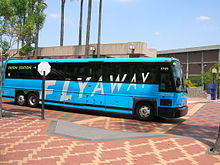 | |
Flyaway bus in service. |
The FlyAway Bus is a shuttle service run by the LAWA, which travels between one of four off-airport locations: Van Nuys, Union Station, Westwood and the Irvine Transportation Center in Orange County. The shuttle service stops at every LAX terminal. The service hours vary based on the line. All lines use the regional system of High Occupancy Vehicle lanes to expedite their trips.
Metro
Shuttle bus "G" offers a free connection to the Aviation/LAX station on the Metro Green Line. The line was originally intended to connect directly to the airport, but budgetary restraints and opposition from local long-term parking lot owners impeded its progress. A Metro Rail extension to LAX is a part of both LAX and Metro's master plans. Shuttle bus "G" runs every 20 minutes, 5am - midnight.
Taxis and private shuttles
Taxicab services are operated by nine city-authorized taxi companies and regulated by Authorized Taxicab Supervision Inc. (ATS). ATS maintains a taxicab holding lot under the 96th Street Bridge where, at peak periods, hundreds of cabs queue up to wait their turn to pull into the central terminal area to pick up riders. A number of private shuttle companies also offer limousine and bus services to LAX airport.
Coast Guard Air Station Los AngelesThe United States Coast Guard operates an air station at LAX, covering Coast Guard operations in various Southern California locations, including Catalina Island, which are part of the Coast Guard's Eleventh District. Missions include search and rescue (SAR), Law enforcement, aids to navigation support (such as operating lighthouses) and various military operations. In addition, Coast Guard helicopters assigned to the air station deploy to Coast Guard cutters. The air station currently maintains and operates 3 HH-65 Dolphin helicopters.
Flight Path Learning Center
The Flight Path Learning Center is a museum located at 6661 Imperial Highway and was formerly known as the "West Imperial Terminal." This building used to house some charter flights (Condor Airlines) and regular scheduled flights by MGM Grand Air. It sat empty for 10 years until it was re-opened as a learning center for LAX.
The center contains information on the history of aviation, several pictures of the airport, as well as aircraft scale models, flight attendant uniforms, and general airline memorabilia such as playing cards, china, magazines, signs, even a TWA gate information sign.
The museum claims to be "the only aviation museum and research center situated at a major airport and the only facility with a primary emphasis on contributions of civil aviation to the history and development of Southern California". However, there are other museums at major airports including the Udvar-Hazy Center of the National Air and Space Museum adjacent to Washington Dulles Airport, the Royal Thai Air Force Museum at Don Muang Airport, the Suomen ilmailumuseo (Finnish Aviation Museum) at Helsinki-Vantaa Airport, the Frontier of Flight Museum at Dallas Love Field, and others.
Incidents involving LAX
During its history there have been numerous incidents, but only the most notable are summarized below:
1950s
- On the morning of June 30, 1956, United Airlines Flight 718, a Douglas DC-7, and TWA Flight 2, a Lockheed Super Constellation, departed LAX within three minutes of each other on eastbound transcontinental flights. The two propeller-driven airliners subsequently collided over the Grand Canyon in Arizona while both were flying in unmonitored airspace, killing all 58 people aboard Flight 718 and 70 people aboard Flight 2.
1960s
- On January 13, 1969, a Scandinavian Airlines System Douglas DC-8-62 crashed into Santa Monica Bay, approximately 6 nautical miles (11 km) west of LAX at 7:21 pm, local time. The aircraft was operating as flight SK-933, nearing the completion of a flight from Seattle. Of nine crewmembers, three lost their lives to drowning, while 12 of the 36 passengers also drowned.
- On January 18, 1969, United Airlines Flight 266 a Boeing 727-22C bearing the registration number N7434U, crashed into Santa Monica Bay approximately 11.3 miles (18.2 km) west of LAX at 6:21 p.m. local time. The aircraft was destroyed, resulting in the loss of all 32 passengers and six crewmembers aboard.
1970s
- On the evening of June 6, 1971, Hughes Airwest Flight 706, a Douglas DC-9 jetliner which had departed LAX on a flight to Salt Lake City, Utah, was struck nine minutes after takeoff by a U.S. Marine Corps McDonnell Douglas F-4 Phantom II fighter jet over the San Gabriel Mountains. The midair collision killed all 44 passengers and five crew members aboard the DC-9 airliner and one of two crewmen aboard the military jet.
- On August 6, 1974, a bomb exploded near the Pan Am ticketing area at Terminal 2; three people were killed and 35 were injured.
- On March 1, 1978, two tires burst in succession on a Continental Airlines McDonnell Douglas DC-10-10 during its takeoff roll at LAX and the plane, bound for Honolulu, veered off the runway. A third tire burst and the DC-10's left landing gear collapsed, causing a fuel tank to rupture. Following the aborted takeoff, spilled fuel ignited and enveloped the center portion of the aircraft in flames. During the ensuing emergency evacuation, a husband and wife died when they exited the passenger cabin onto the wing and dropped down directly into the flames. Two additional passengers died of their injuries approximately three months after the accident; 74 others aboard the plane were injured, as were 11 firemen battling the fire.
- On the morning of September 25, 1978, Pacific Southwest Airlines Flight 182, which was on a Sacramento-Los Angeles International Airport-Lindbergh Field, San Diego route, collided in midair with a Cessna 172 while descending for a landing at Lindbergh Field; both planes crashed in San Diego's North Park district, killing all 135 on board the PSA jetliner, both occupants of the Cessna aircraft, and seven people on the ground.
- On the evening of March 10, 1979, Swift Aire Flight 235, a twin-engine Aerospatiale Nord 262A-33 turboprop enroute to Santa Maria, was forced to ditch in Santa Monica Bay after experiencing engine problems upon takeoff from LAX. The pilot, co-pilot and a female passenger drowned when they were unable to exit the aircraft after the ditching. The female flight attendant and the three remaining passengers—two men and a pregnant woman—survived and were rescued by several pleasure boats and other watercraft in the vicinity.
- On May 25, 1979, American Airlines Flight 191 crashed upon takeoff from O'Hare International Airport in Chicago to Los Angeles, killing all 271 people on board and two people on the ground. The crash remains the deadliest single-aircraft crash in United States history, and the worst aviation disaster in the nation before 9/11.
1980s
- On August 31, 1986, Aeroméxico Flight 498, a DC-9 en route from Mexico City, Mexico to Los Angeles, began its descent into LAX when a Piper Cherokee collided with the DC-9's left horizontal stabilizer over Cerritos, California, causing the DC-9 to crash into a residential neighborhood. All 64 passengers and crew aboard the Aeroméxico flight were killed, in addition to 15 on the ground. 5 homes were destroyed and an additional 7 were damaged by the crash and resulting fire. The three occupants of the Piper were killed immediately when the two planes collided; their aircraft went down in a nearby schoolyard and caused no further injuries on the ground. As a result of this incident, FAA required all commercial aircraft to be equipped with Traffic Collision Avoidance System (TCAS).
- On December 7, 1987, Pacific Southwest Airlines PSA Flight 1771, bound from LAX to San Francisco International Airport, was cruising above the central California coast when a USAir employee aboard the plane shot his ex-supervisor, both pilots and then himself, causing the airplane to crash near the town of Cayucos. All 43 aboard perished. Following this event, airline staff and crew were no longer allowed to bypass security checks at U.S. airports.
1990s
- On February 1, 1991, USAir Flight 1493, a Boeing 737, landing on Runway 24L at LAX, collided on touchdown with a SkyWest Airlines Fairchild Metroliner, Flight 5569 departing to Palmdale, that had been holding in position on the same runway. The collision killed all 12 occupants of the SkyWest plane and 22 people aboard the USAir 737.
- On February 20, 1992, Aerolíneas Argentinas Flight 386, cholera-tainted shrimp was distributed on the Buenos Aires-Lima-Los Angeles flight. One elderly passenger died from food poisoning.
- On April 6, 1993: China Eastern Airlines Flight 583 went into severe oscillations during flight. The aircraft made an emergency landing in Alaska. Two of the passengers ultimately died.
2000s
- Al-Qaeda attempted to bomb LAX on New Year's Eve 1999/2000. The bomber, Algerian Ahmed Ressam, was captured in Port Angeles, Washington, the U.S. port of entry, with a cache of explosives that could have produced a blast 40x greater than that of a devastating car bomb hidden in the trunk of the rented car in which he had traveled from Canada. He had planned to leave one or two suitcases filled with explosives in an LAX passenger waiting area. He was initially sentenced to 22 years in prison, but in February 2010 an appellate court ordered that his sentence be extended.
- On the afternoon of January 31, 2000, Alaska Airlines Flight 261, a McDonnell Douglas MD-83 jetliner flying from Puerto Vallarta, Mexico to San Francisco and Seattle, requested to make an emergency landing at LAX after experiencing control problems with its tail-mounted horizontal stabilizer. Before the plane could divert to Los Angeles, it suddenly plummeted into the Pacific Ocean approximately 2.7 miles (4.3 km) north of Anacapa Island off the California coast, killing all 88 people aboard the aircraft.
- Three of the four planes used on the September 11, 2001 terrorist attacks were originally headed for Los Angeles. American Airlines Flight 11, and United Airlines Flight 175, were from Logan International Airport, in Boston, Massachusetts, and American Airlines Flight 77 was from Washington Dulles International Airport, in Dulles, Virginia.
- In the 2002 Los Angeles Airport shooting of July 4, 2002, Hesham Mohamed Hadayet killed 2 Israelis at the ticket counter of El Al Airlines at LAX. Although the gunman was not linked to any terrorist group, the man was upset at U.S. support for Israel, and therefore was motivated by political disagreement. This led the FBI to classify this shooting as a terrorist act, one of the few on U.S. soil since the September 11, 2001, terrorist attacks. The attack was similar to the Rome and Vienna Airport Attacks.
- On September 21, 2005, a JetBlue Airbus A320 (JetBlue Airways Flight 292) discovered a problem with its landing gear as it took off from Bob Hope Airport in Burbank, California. It flew in circles for three hours to burn off fuel, then landed safely at Los Angeles International Airport on runway 25L, balancing on its back wheels as it rolled down the center of the runway. Passengers were able to watch their own coverage live from the satellite broadcast on JetBlue in-flight TV seat displays of their plane as it made an emergency landing with the front landing gear visibly becoming damaged. Because JetBlue did not serve LAX at the time, the aircraft was evaluated and repaired at a Continental Airlines hangar.
- On July 29, 2006, after America West Express Flight 6008, a Canadair Regional Jet operated by Mesa Airlines from Phoenix, Arizona, landed on runway 25L, controllers instructed the pilot to leave the runway on a taxiway known as "Mike" and stop short of runway 25R. Even though the pilot read back the instructions correctly, he accidentally taxied onto 25R and into the path of a departing SkyWest Airlines Embraer EMB-120 operating United Express Flight 6037 to Monterey, California. They cleared each other by 50 feet (15 m) and nobody was hurt.
- On August 16, 2007, a runway incursion occurred between WestJet Flight 900 and Northwest Airlines Flight 180 on runways 24R and 24L, respectively, with the aircraft coming within 37 feet (11 m) of each other. The planes were carrying a combined total of 296 people, none of whom were injured. The NTSB concluded that the incursion was the result of controller error. In September 2007, FAA Administrator Marion Blakey stressed the need for LAX to increase lateral separation between its pair of north runways in order to preserve the safety and efficiency of the airport.
Planned modernization
LAWA currently has several plans to modernize LAX. These include terminal and runway improvements, which will enhance the passenger experience, reduce overcrowding, and provide airport access to the latest class of very large passenger aircraft.
These improvements include:
- New crossfield taxiway
- New large aircraft gates at TBIT
- TBIT core improvements
- New Midfield Satellite Concourse
- Replacement of Central Utility Plant
- New Central Terminal Processor
LAWA is also planning to build and operate an LAX Automated People Mover. This small train will connect passengers between the central terminal area and the Metro Green Line, the future Metro Crenshaw Line, and regional and local bus lines.
In popular culture
- "L.A. International Airport", a song written by Leanne Scott and first recorded by David Frizzell in 1970, was covered in 1971 by Susan Raye and this version reached #9 on the Billboard Country Singles chart (and #54 on the Hot 100 singles chart). The song was re-recorded with updated lyrics in 2003 by Shirley Myers for the 75th anniversary of LAX.
- The 1994 film Speed, starring Keanu Reeves and Sandra Bullock, was filmed in part on the runways of LAX
- Susan Raye, who has been retired from the music industry since 1986, made a rare public appearance to sing her classic hit at a concert at the celebration and to be on hand when a proclamation was issued to make the song the official song of LAX.
- Los Angeles Rapper Game had a 2008 album titled LAX.
- LAX is referred to at the beginning of "Party in the U.S.A." (2009) by Miley Cyrus.
- In the final season premiere of Lost, notably titled LA X, the alternate timeline sequences are mostly set in LAX, which was the intended destination of Oceanic Airlines Flight 815.
- Rapper Xzibit also had a song titled LAX.
- The airport is featured in the video of the Backstreet Boys song "I Want It That Way". As they sing the chorus, the band dances at the Tom Bradley International Terminal. The plane featured in the video is a Boeing 727
- In the 1995 film Heat, the final scene takes place within the airport's freight terminal.
- LAX appears as a playable level (the last level) in Splinter Cell: Pandora Tomorrow, where the smallpox virus is supposed to be released killing thousands of people.
- Appears in various episodes of the A-Team TV series.
- Featured in the Adam-12 1971 season 4 episode Sub Station Officers Pete Malloy (Martin Milner) and Jim Reed (Kent McCord)spend a week at the LAPD sub station
- The signature monument dome at the front of one of the terminals is featured in Grand Theft Auto San Andreas at Las Venturas Airport.
The above content comes from Wikipedia and is published under free licenses – click here to read more.
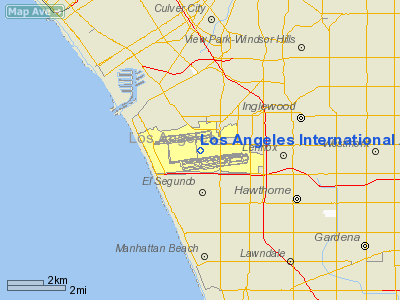
|
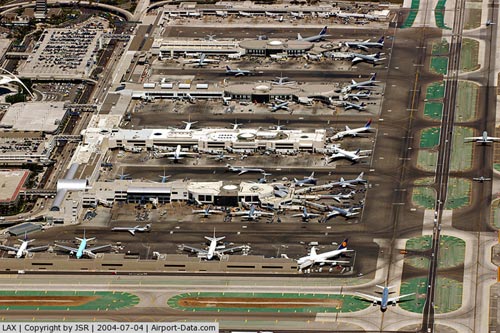 |
(Click on the photo to enlarge) |
|
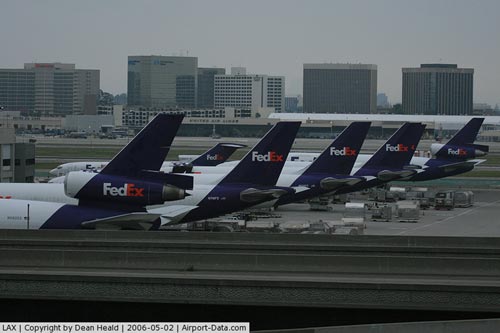 |
(Click on the photo to enlarge) |
|
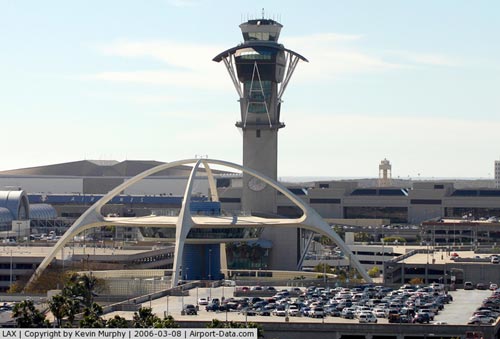 |
(Click on the photo to enlarge) |
|
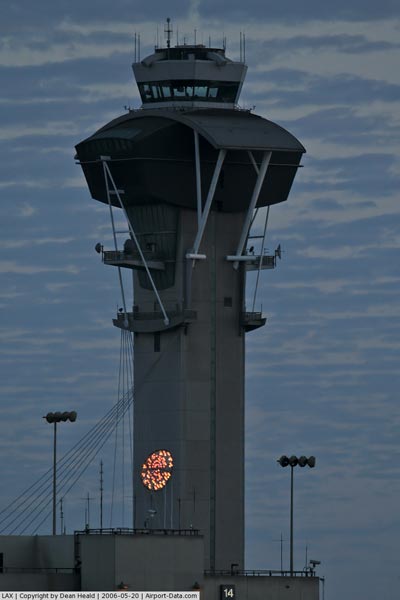 |
(Click on the photo to enlarge) |
|
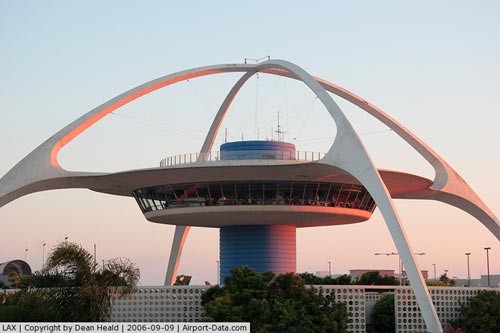 |
(Click on the photo to enlarge) |
|
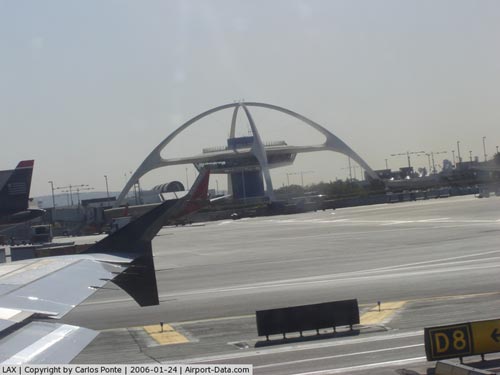 |
(Click on the photo to enlarge) |
Location
& QuickFacts
|
FAA
Information Effective: |
2006-09-28 |
|
Airport
Identifier: |
LAX |
|
Longitude/Latitude: |
118-24-29.0680W/33-56-33.1301N
-118.408074/33.942536 (Estimated) |
|
Elevation: |
126 ft / 38.40 m (Surveyed) |
|
Land: |
3500 acres |
|
From
nearest city: |
9 nautical miles SW of Los Angeles, CA |
|
Location: |
Los Angeles County, CA |
|
Magnetic Variation: |
14E (1985) |
Owner
& Manager
|
Ownership: |
Publicly owned |
|
Owner: |
City Of Los Angeles |
|
Address: |
No 1 World Way Box 92216
Los Angeles, CA 90009-2216 |
|
Phone
number: |
310-646-4265
ARPT OPNS 24 HRS. |
|
Manager: |
Jens Rivera
CHIEF SUPERINTENDANT OF OPERATIONS |
|
Address: |
7301 World Way West, 9th Fl, 9th Floor
Los Angeles, CA 90045-5830 |
|
Phone number: |
310-646-4267 |
Airport
Operations and Facilities
|
Airport
Use: |
Open to public |
|
Wind
indicator: |
Yes |
|
Segmented
Circle: |
No |
|
Control
Tower: |
Yes |
|
Attendance
Schedule: |
ALL/ALL/ALL |
|
Lighting
Schedule: |
DUSK-DAWN |
|
Beacon
Color: |
Clear-Green (lighted land airport) |
|
Sectional
chart: |
Los Angeles |
|
Region: |
AWP - Western-Pacific |
|
Boundary
ARTCC: |
ZLA - Los Angeles |
|
Tie-in
FSS: |
HHR - Hawthorne |
|
FSS
on Airport: |
No |
|
FSS
Phone: |
310-970-0102 |
|
FSS
Toll Free: |
1-800-WX-BRIEF |
|
NOTAMs
Facility: |
LAX (NOTAM-d service avaliable) |
|
Certification type/date: |
I ES 5/1973 |
|
Federal Agreements: |
NGPY3 |
Airport
Communications
Airport
Services
|
Fuel
available: |
A |
|
Airframe
Repair: |
MAJOR |
|
Power
Plant Repair: |
MAJOR |
|
Bottled
Oxygen: |
HIGH |
|
Bulk
Oxygen: |
HIGH |
|
Runway Information
Runway 06L/24R
|
Dimension: |
8925 x 150 ft / 2720.3 x 45.7 m |
|
Surface: |
CONC, Good Condition |
|
Surface
Treatment: |
Saw-cut or plastic Grooved |
|
Weight
Limit: |
Single wheel: 175000 lbs.
Dual wheel: 225000 lbs.
Dual tandem wheel: 400000 lbs.
Dual dual tandem wheel: 900000 lbs. |
|
Edge
Lights: |
High |
|
|
Runway 06L |
Runway 24R |
|
Longitude: |
118-25-52.1557W |
118-24-06.9991W |
|
Latitude: |
33-56-56.7894N |
33-57-07.5582N |
|
Elevation: |
112.00 ft |
117.00 ft |
|
Alignment: |
83 |
127 |
|
ILS
Type: |
ILS/DME |
ILS/DME |
|
Traffic
Pattern: |
Left |
Right |
|
Markings: |
Precision instrument, Good Condition |
Precision instrument, Good Condition |
|
Crossing
Height: |
77.00 ft |
0.00
ft |
|
VASI: |
4-light PAPI on left side |
|
|
Visual
Glide Angle: |
3.00� |
0.00� |
|
RVR
Equipment: |
touchdown, midfield, rollout |
touchdown, midfield, rollout |
|
Approach
lights: |
MALSR |
ALSF2
ALSF2 NOTE:ALS OPERS AS SSALR TIL WEA GOES BELOW VFR. |
|
Runway
End Identifier: |
No |
No |
|
Centerline
Lights: |
Yes |
Yes |
|
Touchdown
Lights: |
No |
Yes |
|
Obstruction: |
61 ft pole, 3000.0 ft from runway, 300 ft left
of centerline, 45:1 slope to clear |
42 ft sign, 1700.0 ft from runway, 350 ft right
of centerline, 35:1 slope to clear |
|
Runway 06R/24L
|
Dimension: |
10285 x 150 ft / 3134.9 x 45.7 m |
|
Surface: |
CONC, Good Condition |
|
Surface
Treatment: |
Saw-cut or plastic Grooved |
|
Weight
Limit: |
Single wheel: 175000 lbs.
Dual wheel: 225000 lbs.
Dual tandem wheel: 400000 lbs.
Dual dual tandem wheel: 900000 lbs. |
|
Edge
Lights: |
High |
|
|
Runway 06R |
Runway 24L |
|
Longitude: |
118-26-07.1589W |
118-24-05.9885W |
|
Latitude: |
33-56-48.2739N |
33-57-00.6833N |
|
Elevation: |
108.00 ft |
111.00 ft |
|
Alignment: |
83 |
127 |
|
ILS
Type: |
ILS/DME |
ILS/DME |
|
Traffic
Pattern: |
Left |
Right |
|
Markings: |
Precision instrument, Good Condition |
Precision instrument, Good Condition |
|
Crossing
Height: |
78.00 ft |
0.00
ft |
|
Displaced
threshold: |
331.00 ft |
0.00
ft |
|
VASI: |
4-light PAPI on left side |
|
|
Visual
Glide Angle: |
3.00� |
0.00� |
|
RVR
Equipment: |
touchdown, midfield, rollout |
touchdown, midfield, rollout |
|
Approach
lights: |
MALSR |
MALSR |
|
Runway
End Identifier: |
No |
No |
|
Centerline
Lights: |
Yes |
Yes |
|
Touchdown
Lights: |
Yes |
No |
|
Obstruction: |
9 ft pole, 275.0 ft from runway, 375 ft right
of centerline, 8:1 slope to clear
APCH RATIO 50:1 TO DSPLCD THR. |
, 50:1 slope to clear
ALS LIGHT BENCH AT 200'. |
|
Runway 07L/25R
|
Dimension: |
12091 x 150 ft / 3685.3 x 45.7 m |
|
Surface: |
CONC, Good Condition |
|
Surface
Treatment: |
Saw-cut or plastic Grooved |
|
Weight
Limit: |
Single wheel: 175000 lbs.
Dual wheel: 225000 lbs.
Dual tandem wheel: 400000 lbs.
Dual dual tandem wheel: 900000 lbs. |
|
Edge
Lights: |
High |
|
|
Runway 07L |
Runway 25R |
|
Longitude: |
118-25-09.6116W |
118-22-47.1791W |
|
Latitude: |
33-56-08.9742N |
33-56-23.5416N |
|
Elevation: |
118.00 ft |
92.00 ft |
|
Alignment: |
83 |
127 |
|
ILS
Type: |
ILS/DME |
ILS/DME |
|
Traffic
Pattern: |
Right |
Left |
|
Markings: |
Precision instrument, Good Condition |
Precision instrument, Good Condition |
|
Crossing
Height: |
59.00 ft |
0.00
ft |
|
Displaced
threshold: |
0.00
ft |
957.00 ft |
|
VASI: |
4-light PAPI on left side |
|
|
Visual
Glide Angle: |
3.00� |
0.00� |
|
RVR
Equipment: |
touchdown, midfield, rollout |
touchdown, midfield, rollout |
|
Approach
lights: |
MALSR |
MALSR |
|
Runway
End Identifier: |
No |
No |
|
Centerline
Lights: |
Yes |
Yes |
|
Touchdown
Lights: |
Yes |
No |
|
Obstruction: |
, 400 ft right of centerline, 50:1 slope to
clear |
25 ft rr, 325.0 ft from runway, 5:1 slope to
clear
APCH RATIO 33:1 TO DSPLCD THR. CTLG OBS IS A +29' SIGN LOCATED
1450' FM DSPLCD THR AND 500' R OF CNTRLN.
14
FT BLAST FENCE AT 180. |
|
Runway 07R/25L
|
Dimension: |
11096 x 200 ft / 3382.1 x 61.0 m |
|
Surface: |
CONC, Good Condition |
|
Surface
Treatment: |
Saw-cut or plastic Grooved |
|
Weight
Limit: |
Single wheel: 175000 lbs.
Dual wheel: 225000 lbs.
Dual tandem wheel: 400000 lbs.
Dual dual tandem wheel: 900000 lbs. |
|
Edge
Lights: |
High |
|
|
Runway 07R |
Runway 25L |
|
Longitude: |
118-25-08.5333W |
118-22-57.8261W |
|
Latitude: |
33-56-01.6630N |
33-56-15.0313N |
|
Elevation: |
118.00 ft |
95.00 ft |
|
Alignment: |
83 |
127 |
|
ILS
Type: |
ILS/DME |
ILS/DME |
|
Traffic
Pattern: |
Right |
Left |
|
Markings: |
Precision instrument, Good Condition |
Precision instrument, Good Condition |
|
Crossing
Height: |
56.00 ft |
0.00
ft |
|
VASI: |
4-light PAPI on left side |
|
|
Visual
Glide Angle: |
3.00� |
0.00� |
|
RVR
Equipment: |
touchdown, midfield, rollout |
touchdown, midfield, rollout |
|
Approach
lights: |
MALSR |
ALSF2
ALSF2 NOTE:ALS OPERATES AS SSALR UNTIL WEATHER GOES BELOW
VFR. |
|
Runway
End Identifier: |
No |
No |
|
Centerline
Lights: |
Yes |
Yes |
|
Touchdown
Lights: |
No |
Yes |
|
Obstruction: |
67 ft pole, 2400.0 ft from runway, 825 ft right
of centerline, 32:1 slope to clear |
21 ft rr, 1150.0 ft from runway, 600 ft left
of centerline, 45:1 slope to clear |
|
Helipad H3
|
Dimension: |
63 x 63 ft / 19.2 x 19.2 m |
|
Surface: |
CONC, Good Condition |
|
Weight
Limit: |
Single wheel: 15000 lbs. |
|
Edge
Lights: |
Low |
|
|
Runway H3 |
Runway |
|
Traffic
Pattern: |
Left |
Left |
|
Markings: |
Basic, |
, |
|
Radio Navigation
Aids
|
ID |
Type |
Name |
Ch |
Freq |
Var |
Dist |
|
CPM |
NDB |
Compton |
|
378.00 |
15E |
8.6 nm |
|
PAI |
NDB |
Pacoima |
|
370.00 |
15E |
19.1 nm |
|
EMT |
NDB |
El Monte |
|
359.00 |
15E |
20.7 nm |
|
GWF |
NDB |
Gen William J Fox |
|
282.00 |
15E |
48.8 nm |
|
NTD |
TACAN |
Point Mugu |
043X |
|
15E |
37.2 nm |
|
RAL |
VOR |
Riverside |
|
112.40 |
15E |
47.8 nm |
|
SMO |
VOR/DME |
Santa Monica |
045X |
110.80 |
15E |
4.7 nm |
|
VNY |
VOR/DME |
Van Nuys |
078X |
113.10 |
15E |
17.4 nm |
|
VTU |
VOR/DME |
Ventura |
019X |
108.20 |
15E |
33.6 nm |
|
ELB |
VOR/DME |
El Toro |
119X |
117.20 |
14E |
37.4 nm |
|
CMA |
VOR/DME |
Camarillo |
105X |
115.80 |
15E |
37.8 nm |
|
LAX |
VORTAC |
Los Angeles |
083X |
113.60 |
15E |
1.3 nm |
|
SLI |
VORTAC |
Seal Beach |
104X |
115.70 |
15E |
20.1 nm |
|
POM |
VORTAC |
Pomona |
041X |
110.40 |
15E |
32.0 nm |
|
SXC |
VORTAC |
Santa Catalina |
051X |
111.40 |
15E |
34.1 nm |
|
FIM |
VORTAC |
Fillmore |
072X |
112.50 |
15E |
34.3 nm |
|
PDZ |
VORTAC |
Paradise |
059X |
112.20 |
15E |
43.8 nm |
|
PMD |
VORTAC |
Palmdale |
092X |
114.50 |
15E |
44.8 nm |
|
LHS |
VORTAC |
Lake Hughes |
021X |
108.40 |
15E |
45.3 nm |
|
LAX |
VOT |
San Pedro Hill |
|
113.90 |
|
12.4 nm |
|
SNA |
VOT |
Santa Ana |
|
110.00 |
|
31.3 nm |
Remarks
- RWY
07L/25R FAA STRENGTH EVALUATION DC-10-10 540000 LBS; DC-10-30 600000
LBS; L-1011 600000 LBS; B747-SP 630000 LBS.
- NOISE
SENSITIVE ARPT. ON WESTERLY TKOFS NO TURNS BEFORE CROSSING SHORELINE.
OVER-OCEAN
APCHS UTILIZED 2400-0630.
- HELI
H3 CTC TWR FOR TFC PAT.
- TWY
D BTWN D-7 & D-8 (N OF TERMINAL ONE) IS RESTRICTED TO B767 OR SMALLER
ACFT.
- TWY
C BTWN B-1 AND C-1 CLSD INDEFLY.
- PRACTICE
INSTRUMENT APPROACHES & TOUCH AND GO LANDINGS ARE PROHIBITED.
- NMRS
BIRDS ON AND IN VCNTY OF ARPT.
- RY
25L PREFERRED EMERGENCY RY.
- WESTBOUND
B747-400 ACFT ON TWY C PROHIBITED FM SOUTHBOUND TURNS ONTO TWY P WITH
B747 ON GATE 101.
- SIMUL
ACFT OPNS PROHIBITED ON TWYS WG AND G BTWN RY 07L/25R AND RY 07R/25L.
- SIMUL
ACFT OPNS PROHIBITED ON TWYS T AND ST BTWN RY 07L/25R AND 07R/25L.
- TURBULENCE
MAY BE DEFLECTED UPWARD FM THE BLAST FENCE 180' E OF RY 25R.
- SIMULTANEOUS
ACFT OPNS PROHIBITED ON TWY WG AND G BTN RYS 07L/25R AND 07R/25L.
- SIMULTANEOUS
ACFT OPNS PROHIBITED ON TWYS T AND ST BTN RYS 07L/25R AND 07R/25L.
- TOM
BRADLEY INTL TERM GATES: ALL ARR B-747 ACFT SHUT DOWN ENGINES ON TWY
ADJACENT TO GATE AND TOW ONTO GATE.
- TWY
A6 CLSD INDEFLY.
- (CONTACT
TITLE) LAX AIRPORT OPERATIONS - MICHAEL CORLETT (310) 646-4265.
- RWY
06L/24R FAA STRENGTH EVALUATION DC-10-10 430000 LBS; DC-10-30 510000
LBS & L-1011 510000 LBS.
- RWY
07R/25L FAA STRENGTH EVALUATION DC-10-10 400000 LBS; DC-10-30 600000
LBS; L-1011 600000 LBS; B-747-SP 710000 LBS.
- RWY
06R/24L FAA STRENGTH EVALUATION DC-10-10 340000 LBS; DC-10-30 480000
LBS & L-1011 480000 LBS.
- DUAL
WHEEL ACFT UP TO 200000 LBS; DTW UP TO 350000 LBS & DDTW UP TO 834000
LBS AND DC-10-10 TO 430000 LBS; DC-10-30 TO 578000 LBS & L-1011
TO 466000 LBS AND A-300 TO 366000 LBS REGULARLY OPER ON ALL RWYS.
- A
700 X 500' CLEARWAY HAS BEEN REESTABLISHED AT WEST END OF RWY 24R.
- TWYS
C-1, AND (C-7, C-8, C-9 NORTH OF C) AND D BTWN D-8 AND D-7 SOUTH OF
TWY E WILL NOT ACCOMODATE B747 ACFT.
Based Aircraft
|
Aircraft
based on field: |
8 |
|
Jet Engine
Airplanes: |
4 |
|
Military: |
4 |
Major Carriers
Serving This Airport
| Sky West Airlines |
22.4% |
| Southwest Airlines |
18.1% |
| United Airlines |
14.6% |
| American Airlines |
13.6% |
| American Eagle Airlines |
9.4% |
| Delta Air Lines |
5.5% |
| America West Airlines |
3.5% |
| Alaska Airlines |
3.3% |
| Continental Airlines |
2.9% |
| Northwest Airlines |
2.8% |
Most Popular Destinations
| San Diego Intl (SAN) |
6.4% |
| Mc Carran Intl (LAS) |
5.4% |
|
Phoenix Sky Harbor Intl (PHX) |
4.8% |
|
Norman Y. Mineta San Jose Intl (SJC) |
4.4% |
| Metropolitan Oakland Intl (OAK) |
4.2% |
|
John F Kennedy Intl (JFK) |
3.8% |
| San Francisco Intl (SFO) |
3.7% |
| Chicago O'hare Intl (ORD) |
3.6% |
|
Salt Lake City Intl (SLC) |
2.8% |
|
Dallas/fort Worth Intl (DFW) |
2.7% |
Most Popular Aircraft
|
N394AE |
0.7% |
| N901AE |
0.7% |
|
N392AE |
0.6% |
| N389AE |
0.6% |
|
N388AE |
0.6% |
| N393AE |
0.6% |
|
N396AE |
0.6% |
| N390AE |
0.6% |
|
N398AM |
0.6% |
| N370AM |
0.5% |
Operational Statistics
|
Aircraft
Operations: |
3052/Day |
|
Air Carrier: |
41.2% |
|
Air Taxi: |
16.1% |
|
General
Aviation Itinerant: |
1.3% |
|
Military: |
0.3% |
Los Angeles International Airport
Address:
Los Angeles County, CA
Tel:
310-646-4265,
310-646-4267
Images
and information placed above are from
http://www.airport-data.com/airport/LAX/
We
thank them for the data!
| General
Info |
| Country |
United
States |
| State |
CALIFORNIA
|
| FAA ID |
LAX
|
| Latitude |
33-56-33.130N
|
| Longitude |
118-24-29.068W
|
| Elevation |
126 feet
|
| Near City |
LOS ANGELES
|
We don't guarantee the information is fresh and accurate. The data may
be wrong or outdated.
For more up-to-date information please refer to other sources.
|
 |



